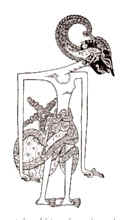Shadow puppet show is an art that has
been aged more than half a millennium. Its
emergence has its own story, related to the entry of Javanese Islam. One member
of the Wali Songo created by adopting Wayang Beber that developed in the heyday
of Hindu-Buddhist. The
adoption was done because the puppet already attached to the Javanese to become
an excellent medium for spreading propaganda of Islam, while Islam prohibits
art form. As a
result, shadow puppets created where people can only see shadows.
Leather puppet played by a man who would be called the public's greatest entertainer in the world. How not, during the night, the mastermind behind the whole character actor playing shadow puppets who are the puppets made of buffalo skin with motifs decorated carving handicrafts decoration (carving the skin). He had to change the character of the sound, changing intonation, removing jokes and even sing. To turn the atmosphere, the puppeteer who is assisted by musicians playing gamelan and sinden who sing Javanese songs.
The characters in the puppet the whole number in the hundreds. The puppets that are not played are put in a banana stem which is near the mastermind. When played, the puppets will appear as shadows on the white screen in front of the mastermind. The shadow is created because every puppet show using oil lamps as lighting that helps reflecting the puppets being played. Each puppet presents a different story or play. Variety of play is divided into 4 categories: standard play, play carangan, play spin and play writing. The play has a story that grip entirely sourced in a library puppet plays while in outline only carangan only sourced the library puppet. Play spin the story did not originate on the puppet, but wearing the appropriate places in the library puppet, while the essay is entirely off the plays.
Puppet story rooted in some older books such as Ramayana, Mahabharata, Kings and Purwakanda Library. Now, there are also books containing composition plays and essays are for hundreds of years has been appreciated by the public Abhimanyu Kerem, Doraweca, Suryatmaja Thieves and so on. Among all the old books were used, the Book of Purwakanda is the most frequently used by puppeteers from Yogyakarta Kingdom. Leather puppet begins when the mastermind has issued the mountains. An all-night wayang performance Yogyakarta style is divided into 3 round which has 7 rows (scene) and 7 scenes of war. The first round, called pathet lasem, has 3 rows and 2 scenes that accompanied the war-gending gending pathet lasem. Pathet Sanga the second half has 2 rows and 2 scenes of war, while the Pathet Manura the third round has 2 rows and 3 scenes of war. One of the most anticipated lots of people on each puppet is because of the joke-joke presents a typical Java.
The following Figure 5 puppets that are often told (Pendawa five figures)
- The five Pendawas consist of Puntadewa (Yudistira, Bima, Arjuna, Nakula and Sadewa). Puntadewa, Bima, and Arjuna were born from the wedding of King Pandudewanata with Queen Dewi Kunti. On the other hand, Nakula and Sadewa were born from the wedding of King Pandudewanata with Queen Dewi Madrim.
2. Puntadewanata or Pandu is the oldest of Five Pendawas. He is so patient so that he is often called as having the white blood. He would never fight or go to war. He has a powerful amulet named Kalimasada.
3. The second Pendawa is Bima or Werkodara. He has a large, strong body and has very sharp thumbnails. He never uses formal language to anyone (except to Dewaruci). He represents the power of Five Pendawas.
4. The third Pendawa is Arjuna. He is a handsome warrior. He is also powerful. He practices meditation; therefore he has received lots of powerful weaponry. He is very skilled in the art of archery.
5. The fourth and Fifth of Pendawas are Nakula and Sahadewa. Like their step-brothers, both of these warrior has supernatural power. Eventhough they have different mother, Nakula and Sadewa are always loyal to their three step-brothers.















0 Response to "Indonesia Wayang Culture In The and Of Java"
Post a Comment
please write your comments in this post